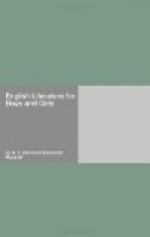The first three books tell the adventures of the Red Cross Knight St. George, or Holiness; of Sir Guyon, or Temperance; and of the Lady Britomartis, or Chastity. The whole poem is an allegory. Everywhere we are meant to see a hidden meaning. But sometimes the allegory is very confused and hard to follow. So at first, in any case, it is best to enjoy the story and the beautiful poetry, and not trouble about the second meaning. Spenser plunges us at once into the very middle of the story. He begins:
“A gentle Knight was
pricking on the plain,
Yelad in mighty arms and silver
shield,
Wherein old dints of deep
wounds did remain,
The cruel marks of many a
bloody field;
Yet arms till that time did
he never wield.
His angry steed did chide
his foaming bit,
As much disdaining to the
curb to yield:
Full jolly knight he seem’d,
and fair did sit,
As one for knightly jousts
and fierce encounters fit.
But on his breast a bloody
cross he bore,
The dear remembrance of his
dying Lord,
For whose sweet sake that
glorious badge he wore,
And dead as living ever him
ador’d;
Upon his shield the like was
also scor’d.”
And by the side of this Knight rode a lovely Lady upon a snow-white ass. Her dress, too, was snow-white, but over it she wore a black cloak, “as one that inly mourned,” and it “seemed in her heart some hidden care she had.”
So the story begins; but why these two, the grave and gallant Knight and the sad and lovely Lady, are riding forth together we should not know until the middle of the seventh canto, were it not for a letter which Spenser wrote to Raleigh and printed in the beginning of his book. In it he tells us not only who these two are, but also his whole great design. He writes this letter, he says, “knowing how doubtfully all allegories may be construed,” and this book of his “being a continued allegory, or dark conceit,” he thought it good to explain. Having told how he means to write of twenty-four knights who shall represent twenty-four virtues, he goes on to tell us that the Faery Queen kept her yearly feast twelve days, upon which twelve days the occasions of the first twelve adventures happened, which, being undertaken by twelve knights, are told of in these twelve books.
The first was this. At the beginning of the feast a tall, clownish young man knelt before the Queen of the Fairies asking as a boon that to him might be given the first adventure that might befall. “That being granted he rested him on the floor, unfit through his rusticity for a better place.
“Soon after entered a fair Lady in mourning weeds, riding on a white ass with a Dwarf behind her leading a warlike steed, that bore the arms of a knight, and his spear in the Dwarf’s hand.
“She, falling before the Queen of Fairies, complained that her Father and Mother, an ancient King and Queen had been by a huge Dragon many years shut up in a brasen Castle, who thence suffered them not to issue.” And therefore she prayed the Fairy Queen to give her a knight who would slay the Dragon.




